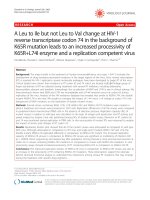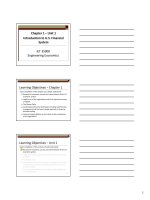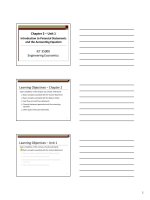Lecture Undergraduate econometrics - Chapter 1: An introduction to econometrics
Bạn đang xem bản rút gọn của tài liệu. Xem và tải ngay bản đầy đủ của tài liệu tại đây (46.95 KB, 20 trang )
Chapter 1
An Introduction to Econometrics
1.1
Why Study Econometrics?
• Econometrics is a set of research tools also employed in the business disciplines of
accounting, finance, marketing and management. It is also used by social scientists,
specifically researchers in history, political science and sociology. Econometrics plays
an important role in such diverse fields as forestry, and in agricultural economics.
• A gap exists between what you have learned as an economics student and what
economists actually do. Most economists use economic data to estimate economic
relationships, test economic hypotheses, and predict economic outcomes. Studying
Slide 1.1
Undergraduate Econometrics, 2nd Edition-Chapter 1
econometrics fills a gap between being “a student of economics” and being “a
practicing economist.”
• If your goal is to earn a master’s or Ph.D. degree in economics, finance, accounting,
marketing, agricultural economics, sociology, political science, or forestry, you will
encounter more econometrics in your future.
By taking this introduction to
econometrics you will gain an overview of what econometrics is about, and develop
some “intuition” about how things work, before entering a technically oriented course.
Slide 1.2
Undergraduate Econometrics, 2nd Edition-Chapter 1
1.2
What is Econometrics?
• In economics we express our ideas about relationships between economic variables
using the mathematical concept of a function.
• For example, to express a relationship between income i and consumption c, we may
write c = f(i).
• The demand for an individual commodity, say the Honda Accord, might be expressed
as
q d = f ( p, p s , p c , i )
d
which says that the quantity of Honda Accords demanded, q , is a function
f ( p, p s , p c , i ) of the price of Honda Accords p, the price of cars that are substitutes ps,
the price of items that are complements pc, like gasoline, and the level of income i.
• The supply of an agricultural commodity such as beef might be written as
Slide 1.3
Undergraduate Econometrics, 2nd Edition-Chapter 1
q s = f ( p, p c , p f )
s
where q is the quantity supplied, p is the price of beef, pc is the price of competitive
products in production (for example, the price of hogs), and pf is the price of factors or
inputs (for example, the price of corn) used in the production process.
• Each of the above equation is a general economic model that describes how we
visualize the way in which economic variables are interrelated. Economic models of
this type guide our economic analysis.
Econometrics is about how we can use economic, business or social science theory and
data, along with tools from statistics, to answer “how much” type questions.
Slide 1.4
Undergraduate Econometrics, 2nd Edition-Chapter 1
1.2.1 Some Examples
• A question facing Alan Greenspan is “How much should we increase the discount rate
to slow inflation, and yet maintain a stable and growing economy?” The answer will
depend on the responsiveness of firms and individuals to increases in the interest rates
and to the effects of reduced investment on Gross National Product.
The key
elasticities and multipliers are called parameters. The values of economic parameters
are unknown and must be estimated using a sample of economic data when
formulating economic policies.
• Econometrics is about how to best estimate economic parameters given the data we
have. “Good” econometrics is important, since errors in the estimates used by policy
makers such as the FRB may lead to interest rate corrections that are too large or too
small, which has consequences for all of us. Other examples include:
Slide 1.5
Undergraduate Econometrics, 2nd Edition-Chapter 1
• A city council ponders the question of how much violent crime will be reduced if
an additional million dollars is spent putting uniformed police on the street.
• U.S. Presidential candidate Gore questions how many additional California voters
will support him if he spends an additional million dollars in advertising in that
state.
• The owner of a local Pizza Hut franchise must decide how much advertising space
to purchase in the local newspaper, and thus must estimate the relationship
between advertising and sales.
• Louisiana State University must estimate how much enrollment will fall if tuition
is raised by $100 per semester, and thus whether its revenue from tuition will rise
or fall.
• The CEO of Proctor & Gamble must estimate how much demand there will be in
ten years for the detergent Tide, as she decides how much to invest in new plant
and equipment.
Slide 1.6
Undergraduate Econometrics, 2nd Edition-Chapter 1
• A real estate developer must predict by how much population and income will
increase to the south of Baton Rouge, Louisiana, over the next few years, and if it
will be profitable to begin construction of a new strip-mall.
• You must decide how much of your savings will go into a stock fund and how
much into the money market. This requires you to make predictions of the level of
economic activity, the rate of inflation and interest rates over your planning
horizon.
• To answer these questions of “how much,” decision makers rely on information
provided by empirical economic research.
In such research, an economist uses
economic theory and reasoning to construct relationships between the variables in
question. Data on these variables are collected and econometric methods are used to
estimate the key underlying parameters and to make predictions.
Slide 1.7
Undergraduate Econometrics, 2nd Edition-Chapter 1
1.3
The Econometric Model
• Economic theory does not claim to be able to predict the specific behavior of any
individual or firm, but rather it describes the average and systematic behavior of many
individuals or firms. When studying Honda car sales we recognize that the actual
number of Hondas sold is the sum of this systematic part and a random and
unpredictable component, e, that we will call a random error.
• An econometric model representing the sales of Honda Accords is
q d = f ( p, p s , p c , i ) + e
• The random error e accounts for the many factors that affect sales that we have
omitted from this simple model, and it also reflects the intrinsic uncertainty in
economic activity.
• To complete the specification of the econometric model, we must also say something
about the form of the algebraic relationship among our economic variables. For
Slide 1.8
Undergraduate Econometrics, 2nd Edition-Chapter 1
example, in your first economics courses quantity demanded was depicted as a linear
function of price. We assume that the systematic part of the demand relation is linear
f ( p, p s , p c , i ) = β1 + β2 p + β3 p s + β4 p c + β5i
• The corresponding econometric model is
q d = β1 + β2 p + β3 p s + β4 p c + β5i + e
• The function form represents a hypothesis about the relationship between the
variables. In a particular problem our interest centers on trying to determine a form
that is compatible with economic theory and the data.
• In every econometric model, there is a systematic portion and an unobservable random
component. The systematic portion is the part we obtain from economic theory, and
Slide 1.9
Undergraduate Econometrics, 2nd Edition-Chapter 1
an assumption about the functional form. The random component represents a “noise”
component, which obscures our understanding of the relationship among variables,
and which we represent using the random variable e.
Slide 1.10
Undergraduate Econometrics, 2nd Edition-Chapter 1
1.4
How Do We Obtain Data?
1.4.1 Experimental Data
• In an ideal world, from a researcher’s point of view, an economic model would
describe how we might design an experiment that could be used to obtain economic
observations or sample information, which then could be used to provide insights
about the unknown economic parameters. Repeating the experiment T times would
create a sample of T sample observations.
• In an ideal world for research, controlled experiments could be conducted to
investigate the relationship between these “explanatory” variables and the “dependent”
variable qd. For example, we might set
p = price of Accords = $25,000
Slide 1.11
Undergraduate Econometrics, 2nd Edition-Chapter 1
ps = price of Maximas = $25,000
pc = price of gasoline per gallon = $1.35
i = income of individuals in sample = $42,000
• At the end of a month we observe the number of Honda Accords sold at one
dealership to be qd = 37.
• By repeating this process a number of times, a sample of economic data is created.
• In every experiment there is an unobservable random error, or noise, that enters the
observable outcome. We sets the values of the primary explanatory variables that are
indicated by economic reasoning, but it is clear that there are “other” substitute and
complement goods whose prices are not controlled. There are unobservable factors
dictating the level of consumer confidence and willingness to spend.
These are
“random” factors that are not controlled, but which affect the outcome we observe by
blurring the picture or adding “noise” to the problem.
Slide 1.12
Undergraduate Econometrics, 2nd Edition-Chapter 1
• The experimental outcome we observe is the sum of a systematic component that
depends on the controlled explanatory variables and this random noise. Consequently,
the experimental outcome is random too.
• We never know what we will observe in any trial of the experiment, and thus the
quantity of Accords sold, qd, is random.
• Every sample of size T we collect will be different, and the differences are due to
“sampling variability,” which is evidence of the presence of the random error e.
• If we repeat the experiment a few times, we obtain observations such as those in Table
1.1.
Slide 1.13
Undergraduate Econometrics, 2nd Edition-Chapter 1
Table 1.1 Monthly Sales of Honda Accords
month
qd
p
ps
pc
i
1
37
25
25
1.35
42
2
28
23
25
1.35
32
3
30
23
25
1.35
32
4
35
20
25
1.35
35
5
40
25
27
1.35
42
6
46
25
30
1.35
52
7
52
25
32
1.35
55
8
55
25
25
1.40
60
9
60
25
25
1.45
70
10
65
25
25
1.55
100
Slide 1.14
Undergraduate Econometrics, 2nd Edition-Chapter 1
• We, the econometricians, wish to determine the relationship between each of the
explanatory variables (p, pc, ps, i) and the dependent variable qd using a sample of T
observations on values of the explanatory variables and the observed quantities sold.
• When the experiments are uncontrolled, economists take the role of observers, and
economic theory indicates the relevant variables to consider. By observing T values of
each economic variable, a sample with T observations is created.
1.4.2 Nonexperimental Data
• Most economic data are collected for administrative rather than research purposes,
often by government agencies. The data may be collected in a:
• time series form—data collected over discrete intervals of time.
• cross section form—data collected over sample units in a particular time period.
• panel data form—data that follow individual micro-units over time.
Slide 1.15
Undergraduate Econometrics, 2nd Edition-Chapter 1
• These data may be collected at various levels of aggregation:
• micro—data collected on individual economic decision making units such as
individuals, households or firms.
• macro—data resulting from a pooling or aggregating over individuals, households
or firms at the local, state or national levels.
• The data collected may also represent a flow or a stock:
• flow—outcome measures over a period of time, such as the consumption of
gasoline during the last quarter of 1999.
• stock—outcome measured at a particular point in time, such as the quantity of crude
oil held by Chevron in its US storage tanks April 1, 1999.
Slide 1.16
Undergraduate Econometrics, 2nd Edition-Chapter 1
• The data collected may be quantitative or qualitative:
• quantitative—outcomes such as prices or income that may be expressed as numbers
or some transformation of them, such as real prices or per capita income.
• qualitative—outcomes that are of an “either-or” situation.
For example, a
consumer either did or did not make a purchase of a particular good, or a person
either is or is not married.
Slide 1.17
Undergraduate Econometrics, 2nd Edition-Chapter 1
1.5
Statistical Inference
The phrase statistical inference will appear often in this book. By this we mean we want
to “infer” or learn something about the real world by analyzing a sample of data. The
ways in which statistical inference are out carried include:
• Estimating economic parameters, such as elasticities, using econometric methods.
• Predicting economic outcomes, such as the enrollment in 2-year colleges in the
U.S. for the next 10 years.
• Testing economic hypotheses, such as the question of whether newspaper
advertising is better than store displays for increasing sales.
Slide 1.18
Undergraduate Econometrics, 2nd Edition-Chapter 1
1.6
A Research Format
1. It all starts with a problem or question.
2. Economic theory gives us a way of thinking about the problem: What economic
variables are involved and what is the possible direction of the relationship(s)?
3. The working economic model leads to an econometric model. We must choose a
functional form and make some assumptions about the nature of the error term.
4. Sample data are obtained, and a desirable method of statistical analysis chosen, based
on our initial assumptions, and our understanding of how the data were collected.
5. Estimates of the unknown parameters are obtained with the help of a statistical
software package, predictions are made and hypothesis tests are performed.
6. Model diagnostics are performed to check the validity of assumptions we’ve made.
For example, were all of the right-hand-side explanatory variables relevant? Was the
correct functional form used?
Slide 1.19
Undergraduate Econometrics, 2nd Edition-Chapter 1
7. The economic consequences and the implications of the empirical results are analyzed
and evaluated.
What economic resource allocation and distribution results are
implied, and what are their policy-choice implications? What remaining questions
might be answered with further study or new and better data?
Slide 1.20
Undergraduate Econometrics, 2nd Edition-Chapter 1









